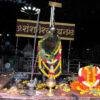During the full moon day, Purnima, or the no moon day, Amavasya, falls inside the month of Jyeshtha in the Hindu calendar. This is the Vat Savitri Vrat, an auspicious day for married Hindu women. From the 13th day, known as “Trayodashi,” till Purnima or Amavasya, the fasting practice concludes. It is mentioned in the scriptures that women who are unable to fast for three days might observe a one-day vrat on the final day.
About Vat Savitri Vrat
With the exception of Vat Savitri Vrat, most Hindu holidays coincide with the same day in the Purnimanta and Amanta lunar calendars. In the Amanta calendar, Vat Savitri Vrat occurs during the “Jyeshtha Purnima” and is referred to as “Vat Purnima Vrat.” In the Purnimanta calendar, it is observed on the “Jyeshtha Amavasya” and is also celebrated as “Shani Jayanti.” For this reason, married women celebrate the Vat Savitri Vrat 15 days after women in northern states commemorate it in Gujarat, Maharashtra, and other southern Indian states. Vat Savitri Vrat falls between May and June on the Gregorian calendar.
Indian married ladies celebrate Vat Savitri Vrat for the health and longevity of their husbands and kids. As per the Hindu folklore, Devi Savitri made Lord Yamaraja, the God of Death, grant her spouse Satyawan’s life back on this same day. She offered her deceased spouse back to Lord Yamaraja since He was so impressed with her devotion. Married women began to pray to the “Vat” (Bargad) tree after that, and Savitri was also commemorated on this day as “Devi Savitri.”
Praying for the growth of their families, they ask for blessings to protect their husbands’ good fortune. The entire country of India celebrates Vat Savitri Vrat with great enthusiasm and devotion.
The Significance of Vat Savitri Vrat
Hindu mythology holds that the Vat (Banyan) tree is a symbol for “Trimurtis,” which stands for Lord Shiva, Lord Brahma, and Lord Vishnu. It is believed that those who worship the banyan tree would be fortunate.
Many holy books and Puranic traditions, such as the Skanda Purana, the Bhavishyottara Purana, the Mahabharata, etc., stress the importance of fasting. Hindu married women fast and do the Vat Savitri puja in order to wish their husbands life, prosperity, and good health.
It is said that observing Vat Savitri Vrat is a sign of a married woman’s genuine love and devotion to her husband.

Rituals during Vat Savitri Vrat
Women get up before sunrise on the day of Vat Savitri Vrat. Sesame seeds, or “gingli,” and Indian gooseberries, or “amla,” are used in their bath. Following their bath, women put on new garments, and bangles, and apply vermillion to their foreheads. Water is consumed along with the roots of the “Vat,” or banyan tree. Over the course of the three days that they follow this fast, the women consume only roots.
Next, the women wrap red or yellow thread around the “Vat” tree in adoration. As part of the puja, they then present rice, water, and flowers. The last ritual is the “parikrama,” in which ladies circle the trees while chanting prayers.
If one is unable to locate or see the banyan tree, one possible solution is to use sandalwood or turmeric paste to create a wooden or plate image of the tree. On this day, special foods are made and puja is performed in a same manner. These preparations are shared among families and friends following the ceremony. ladies in the household ask married ladies and elders for blessings on the day of Vat Savitri Vrat.
Giving to the needy is a highly fulfilling activity on Vat Savitri Vrat. People kindly provide food, cash, and clothing to the underprivileged and destitute on this day.
Relevance of Vat Savitri Vrat
Many Hindu puranic texts, like the “Bhavishyottar Purana” and the “Skanda Purana,” emphasize the immense merits of the Vat Savitri Vrat. Adherents honor the Banyan tree, or “Vat”. A symbol of the “Trimurtis,” or Brahma, Vishnu, and Mahesh, the banyan tree is associated with Hindu mythology. The tree’s trunk symbolizes Lord Vishnu, the upper part of the tree represents Lord Shiva, and the roots represent Lord Brahma. To top it off, the entire “Vat” tree represents “Savitri.” It is a day when women pray for their husbands’ prosperity and good fortune in life. They maintain a sacred fast to protect them.
Date, Time, and Muhurat for Vat Savitri
Vata Savitri Amavasya on Thursday, June 6, 2024
Vat Savitri Purnima Vrat on Friday, June 21, 2024
Amavasya Tithi Begins- June 05 | 10:27 AM in (United States)
Amavasya Tithi Ends- June 06 | 8:37 AM in (United States)

When and where is Vat Purnima Vrat observed?
Hindus who live both in India and elsewhere celebrate the Vat Purnima Vrat. Goddess Gauri and Sati Savitri are honored by this holy vrat. Although it is observed in the Indian states of Delhi, Uttar Pradesh, Bihar, and Orissa, the Vat Purnima Vrat is celebrated in Maharashtra and Gujarat as well. These two states celebrate the festival with tremendous fanfare and spectacle.
“Karadaiyan Nonbu” is the name given to this vrat in southern Indian states like Karnataka and Tamil Nadu. Celebrated with immense enthusiasm throughout India, this vrat is also seen as a representation of women.
Vat Purnima’s Resilience
Hindu texts such as the Skand Purana, Nirnayamrit, and Bhavishyottar Purana, to mention a few, all extol the virtues of Vat Purnima. Married Hindu women observe this holy fast for the health and welfare of their husbands and children.
Not only does the Vat Purnima vrat honor the feminine spirit, but it also helps married couples bond even more. The reason this vrat is so holy and fortunate is because of the confidence in it. Even if they skip fasting, pregnant ladies, working women, or women with medical conditions can perform this puja. They might seek the same blessings as those who faithfully observe the fast by offering their prayers with devotion.
Conclusion
Every year on the new moon day of Krishna Paksha, people celebrate Vat Savitri Vrat. The Vrat is observed in honor of Devi Savitri and is meant to protect the spouse. On this day, women adorn the Banyan tree by wrapping a sacred thread around its trunk. They pray for their husband’s health and keep a fast. This year, on 6th June, is the occasion.



















Add comment